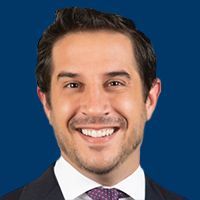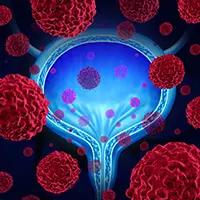Investigational PI3K-γ Inhibitor Eganelisib Plus Nivolumab Elicits Early Efficacy in Head and Neck Cancer, Melanoma
November 13, 2020 - Treatment with the combination of eganelisib, a selective PI3K-γ inhibitor, and nivolumab demonstrated encouraging clinical activity and a favorable safety profile in patients with head and neck squamous cell carcinoma.
Ezra Cohen, MD, FRCPSC, FASCO

Treatment with the combination of eganelisib (IPI-549), a selective PI3K-γ inhibitor, and nivolumab (Opdivo) demonstrated encouraging clinical activity and a favorable safety profile in patients with head and neck squamous cell carcinoma (HNSCC), according to updated findings from an expansion cohort of the ongoing phase 1/1b MARIO-1 trial (NCT02637531) that were presented during the virtual 2020 SITC Annual Meeting.1
The overall response rate (ORR) in patients who had 2 or fewer prior lines of therapy (n = 11) was 20.0% with the combination. As best overall response, 2 patients achieved a partial response (PR) and 2 achieved stable disease (SD).
The disease control rate (DCR) was 40.0% among these patients. The median progression-free survival (PFS) for patients who had 2 or fewer prior lines of therapy was 23 weeks (95% CI, 9-49).
“There is a significant unmet need for patients with head and neck cancer, especially those who are refractory to anti–PD-1 antibodies,” lead study author Ezra Cohen, MD, FRCPSC, FASCO, chief of the Division of Hematology-Oncology, and a medical oncologist at the University of California, San Diego Health,said in a presentation during the meeting. “Checkpoint inhibitors are only active in about 16% of patients and there are limited treatment options for those who don’t respond.”
Eganelisib relieves immune suppression by reprogramming pro-tumor macrophages or myeloid-derived suppressor cells. This mechanism also allows the drug to activate antitumor T cells. T-cell activation can also be maintained with the addition of checkpoint inhibitors, despite IFN-γ–mediated upregulation of PD-L1. As such, there was rationale suggesting that the combination of eganelisib and nivolumab could offer synergistic antitumor benefit.
Patients enrolled in the trial received a combination of continuous eganelisib at 40 mg once daily plus a 240 mg flat dose of intravenous nivolumab once every 2 weeks in 28-day cycles.
All patients had previously been refractory to or relapsed following treatment with anti-PD-1/PD-L1 therapies. After starting therapy, patients were stratified as having progressive disease, SD, or objective response to determine the overall benefit of eganelisib.
The median age was 62 years (range, 29-80), and the majority of patients were male (n = 16; 76.2%). Patients had an ECOG performance status (PS) of 0 (n = 9; 42.9%) or 1 (n = 12; 57.1%).
The majority of patients with known human papillomavirus (HPV) status (n = 12; 57.1%) were HPV-positive (n = 8; 38.1%).
The majority of patients had received 4 or more prior therapies (n = 10; 47.6%). Moreover, 9.5% (n = 2) had 1 prior therapy, 14.3% (n = 3) had 2 prior therapies, and 28.6% (n = 6) had 3 prior therapies. Prior therapies included anti–PD-1/PD-L1 inhibition (n = 21; 100%), chemotherapy (n = 14; 66.7%), anti-EGFR inhibition (n = 12; 57.1%), anti–CLTA-4 inhibition (n = 3; 14.3%), anti-CD20 inhibition (n = 2; 9.5%), and an immune stimulatory agent (n = 2; 9.5%). As the last line of prior therapy, 85.7% of patients (n = 18) received anti–PD-1/PD-L1 inhibition, 9.5% (n = 2) received anti-CD20 inhibition, 4.8% received anti-EGFR inhibition (n = 1), and 4.8% received an immune stimulatory agent (n = 1).
Most patients (42.9%) had progressive disease as the best response to prior anti–PD-1/PD-L1 therapy, followed by 23.8% who achieved a PR, 19.0% who achieved SD, and 14.3% whose best response was unknown.
In the total population of evaluable patients (n = 21), the ORR was 10.0%; no patients who received 3 or more prior lines of therapy obtained a PR. Five patients who had 3 or more prior lines of therapy achieved SD. The DCR was 45.0% in the overall population and 50.0% in patients who had 3 or more prior lines of therapy.
In the overall population, 11 patients developed progressive disease (n = 6, ≤2 prior lines; n = 5, ≥3 prior lines).
The median PFS in patients who had 3 or more prior lines of therapy was 20 months (95% CI, 16-33) and 17 months (95% CI, 9-24) in the total patient population.
Regarding patient disposition and exposure, all patients discontinued treatment for reasons including disease progression (n = 15; 71.4%), adverse effect (AE; n = 2; 9.5%), other (n = 2; 9.5%), death (n = 1; 4.8%), and investigator decision (n = 1; 4.8%).
The median duration of treatment exposure was 11.3 weeks (range, 2.6-48.7), with a median of 3 cycles of therapy completed (range, 1-14). The median rate of eganelisib dose compliance was 91.5%.
Additionally, half of HPV-positive patients (n = 8) achieved SD compared with 0% of HPV-negative patients (n = 3).
Regarding safety, the most common treatment-emergent AEs (TEAEs) occurring in 15% or more of patients included fatigue (n = 13; 61.9%), pyrexia (n = 9; 42.9%), decreased appetite (n = 9; 42.9%), pruritus (n = 6; 28.6%), weight decrease (n = 6; 28.6%), nausea (n = 6; 28.6%), diarrhea (n = 6; 28.6%), dyspnea (n = 5; 23.8%), abdominal pain (n = 5; 23.8%), vomiting (n = 4; 19.0%), myalgia (n = 4; 19.0%), dizziness (n = 4; 19.0%), and headache (n = 4; 19.0%).
Treatment-related TEAEs included fatigue (n = 8; 38.1%), pyrexia (n = 3; 14.3%), decreased appetite (n = 3; 14.3%), pruritus (n = 3; 14.3%), nausea (n = 4; 19.0%), dyspnea (n = 1; 4.8%), abdominal pain (n = 2; 9.5%), vomiting (n = 2; 9.5%), myalgia (n = 2; 9.5%), and dizziness (n = 1; 4.8%). Three patients experienced immune-related, treatment-related pruritus.
Grade 3 or greater TEAEs occurring in at least 5% of patients included anemia (n = 3; 14.3%), disease progression (n = 3; 14.3%), sepsis (n = 2; 9.5%), nausea (n = 2; 9.5%), and abdominal pain (n = 2; 9.5%). One patient each experienced treatment-related anemia, nausea, and abdominal pain. No immune-related, treatment-related TEAEs of grade 3 or greater were observed.
“Eganelisib has the potential to benefit HPV-positive patients who have a T-cell inflamed phenotype and further exploration in this combination is warranted,” said Cohen.
To that end, a phase 2 window-of-opportunity study (NCT03795610) of eganelisib is ongoing in patients with locally advanced HPV-positive and HPV-negative HNSCC.
Melanoma Cohort Demonstrates Similar Efficacy With Eganelisib/Nivolumab
Additional findings from another expansion cohort of the study, which were also presented during the 2020 SITC Virtual Congress, showed that the combination of eganelisib and nivolumab induced an ORR of 10.3% (n = 4) among patients with melanoma (n = 40).2 All 4 patients derived a PR. Ten patients had SD and 24 developed progressive disease.
Notably, all 4 patients had 2 or fewer prior lines of therapy, including those who progressed on immediate prior checkpoint inhibitors (n = 19). This translated to an ORR of 21.1% in this subgroup. An additional 6 patients in this group achieved SD and 9 had progressive disease.
“The significance of this efficacy within this [subgroup] is important since patients with melanoma, particularly BRAF wild-type melanoma, only usually have 2 or fewer lines of prior therapy with PD-1 and CLTA-4 [inhibitors] before needing to seek alternative treatment,” said lead study author Michael A. Postow, MD, a medical oncologist and chief of the Melanoma Service at Memorial Sloan Kettering Cancer Center, in a poster presentation of the data.
No patients who had 3 or more prior lines of therapy (n = 21) derived a response. Four patients in this subgroup had SD, and 15 patients had progressive disease. Additionally, one patient’s best overall response was unknown.
The DCRs were 35.9% (n = 14) in all patients, 52.6% (n = 10) in patients with 2 or fewer prior treatments, and 20.0% (n = 4) in patients with 3 or more prior treatments. The median PFS was 9 weeks (range, 8-16), 17 weeks (range, 8-55), and 16 weeks (range, 8-19), respectively.
Baseline patient characteristics indicated that 100% of patients in the melanoma cohort were refractory to or relapsed following anti–PD-1/PD-L1 therapy. Moreover, 87.5% of patients (n = 35) had immediate prior anti–PD-1/PD-L1 therapy.
Other prior treatments included anti–CLTA-4 therapy (n = 28; 70.0%), investigational immunotherapy (n = 17; 42.5%), MEK/ERK inhibitor (n = 9; 22.5%), BRAF inhibitor (n = 5; 12.5%), and chemotherapy (n = 4; 10.0%).
The median age was 65.5 years (range, 46-86) and half were male (n = 20; 50.0%).
Ten percent (n = 4) of patients derived a complete response as the best response to prior anti–PD-1/PD-L1 therapy; 7.5% (n = 3) had a PR, 45.0% (n = 18) had SD, 25% (n = 10) had progressive disease, and 12.5% (n = 5) had an unknown best response to prior anti–PD-1/PD-L1 therapy.
All-grade TEAEs occurring in more than 15% of patients in the melanoma cohort included increased AST (n = 15; 37.5%), increased ALT (n = 15; 37.5%), fatigue (n = 11; 27.5%), nausea (n = 11; 27.5%), pyrexia (n = 9; 22.5%), decreased appetite (n = 9; 22.5%), anemia (n = 8; 20.0%), pruritus (n = 8; 20.0%), increased ALP (n = 7; 17.5%), vomiting (n = 7; 17.5%), and rash (n = 7; 17.5%). A proportion of each toxicity was found to be treatment related. Immune-related treatment-related TEAEs included increased AST (n = 13; 32.5%), increased ALT (n = 13; 32.5%), pruritus (n = 7; 17.5%), increased ALP (n = 6; 15.0%), and rash (n = 7; 17.5%).
Grade 3 or greater TRAEs included increased AST (n = 9; 22.5%), increased ALT (n = 5; 12.5%), maculo-papular rash (n = 3; 7.5%), and rash (n = 3; 7.5%), all of which were treatment-related and immune-related. Disease progression was also reported (n = 4; 10.0%) but was not treatment-related or immune-related.
The MARIO-1 trial is ongoing, evaluating the combination of eganelisib and nivolumab in patients with non–small cell lung cancer (part E), triple-negative breast cancer (TNBC; part F) adrenocortical carcinoma (part G), mesothelioma (part G), and high-circulating myeloid derived suppressor cells (part H).3
Eganelisib is also being evaluated in combination with nivolumab as second-line therapy for patients with advanced urothelial carcinoma in the phase 2 MARIO-275 trial (NCT03980041) and in combination with atezolizumab (Tecentriq), nab-paclitaxel (Abraxane), and bevacizumab (Avastin), as first-line therapy for patients with TNBC or renal cell carcinoma in the phase 2 MARIO-3 trial (NCT03961698).
References
- Cohen EEW, Postow M, Sullivan R, et al. Updated clinical data from the SCCHN expansion cohort of an ongoing ph1/1b study of eganelisib (IPI-549) in combination with nivolumab. Presented at: 2020 STIC Annual Meeting; November 9-14, 2020; virtual. Abstract 352.
- Postow M, Sullivan RJ, Cohen EEW, et al. Updated clinical data from the melanoma expansion cohort of an ongoing ph1/1b study of eganelisib (IPI-549) in combination with nivolumab. Presented at: 2020 SITC Annual Meeting; November 9-14, 2020; virtual. Abstract 434.
- A dose-escalation study to evaluate the safety, tolerability, pharmacokinetics, and pharmacodynamics of IPI-549. ClinicalTrials.gov. Updated May 28, 2020. Accessed November 12, 2020. https://bit.ly/35mJseq



